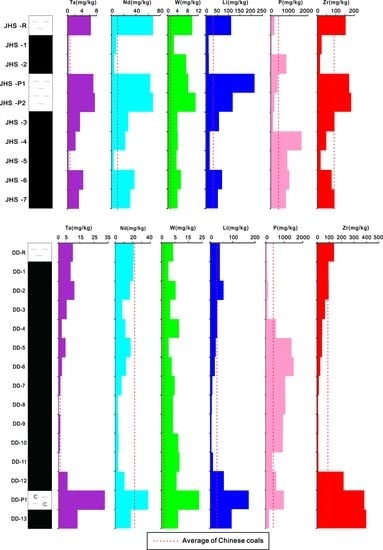Enrichment of Nb-Ta-Zr-W-Li in the Late Carboniferous Coals from the Weibei Coalfield, Shaanxi, North China
Abstract
:1. Introduction
2. Geological Setting
3. Methodology
3.1. Sample Collection
3.2. Analytical Methods
4. Results
4.1. Coal Chemistry
4.2. Coal Mineralogy
4.3. Coal Geochemistry
5. Discussion
5.1. Influence of Sediment Provenance
5.2. Influence of Sea Water
5.3. Influence of Hydrothermal Fluids
5.3.1. Mineralogical Evidence
5.3.2. Geochemical Evidence
6. Conclusions
Author Contributions
Funding
Acknowledgments
Conflicts of Interest
Appendix A
| Coal Mine | Sample No. | Thickness | Mad | HTAd | Vdaf | St,d | Ss,d | Sp,d | So,d |
|---|---|---|---|---|---|---|---|---|---|
| Dongdong | DD-R | 20 | 1.10 | 61.33 | 41.76 | 8.12 | 0.51 | 7.03 | 0.58 |
| DD-1 | 20 | 0.54 | 27.15 | 21.40 | 2.06 | 0.16 | 0.35 | 1.54 | |
| DD-2 | 20 | 0.46 | 25.17 | 20.83 | 2.98 | 0.60 | 1.29 | 1.09 | |
| DD-3 | 20 | 0.41 | 25.72 | 22.31 | 9.02 | 1.74 | 6.86 | 0.42 | |
| DD-4 | 20 | 0.45 | 14.26 | 18.41 | 3.18 | 0.32 | 1.35 | 1.51 | |
| DD-5 | 5 | 0.45 | 14.59 | 17.39 | 2.72 | 0.28 | 1.14 | 1.30 | |
| DD-6 | 20 | 0.36 | 10.62 | 17.24 | 2.75 | 0.28 | 1.06 | 1.41 | |
| DD-7 | 20 | 0.33 | 9.68 | 15.76 | 2.55 | 0.30 | 0.99 | 1.26 | |
| DD-8 | 20 | 0.32 | 20.81 | 25.54 | 4.76 | 0.99 | 2.82 | 0.96 | |
| DD-9 | 20 | 0.40 | 7.61 | 18.35 | 3.39 | 0.63 | 1.30 | 1.46 | |
| DD-10 | 20 | 0.33 | 9.00 | 18.66 | 2.81 | 0.35 | 1.07 | 1.39 | |
| DD-11 | 20 | 0.34 | 12.62 | 20.14 | 4.50 | 0.89 | 2.43 | 1.18 | |
| DD-12 | 10 | 0.38 | 27.75 | 23.27 | 4.47 | 0.42 | 3.14 | 0.91 | |
| DD-P1 | 20 | 0.37 | 71.60 | 43.05 | 0.68 | 0.02 | 0.53 | 0.13 | |
| DD-13 | 20 | 0.39 | 30.57 | 17.69 | 1.26 | 0.03 | 0.36 | 0.87 | |
| Coal Av | - | 0.40 | 18.12 | 19.77 | 3.57 | 0.54 | 1.86 | 1.18 | |
| Jinhuashan | JHS-R | 20 | 1.51 | 88.49 | 72.36 | 0.29 | 0.01 | 0.18 | 0.10 |
| JHS-1 | 20 | 0.26 | 7.13 | 15.67 | 1.45 | 0.03 | 0.13 | 1.29 | |
| JHS-2 | 20 | 0.10 | 7.51 | 17.13 | 1.87 | 0.09 | 0.30 | 1.47 | |
| JHS-P1 | 20 | 0.48 | 67.35 | 29.08 | 0.97 | 0.12 | 0.67 | 0.18 | |
| JHS-P2 | 40 | 0.51 | 81.73 | 61.72 | 1.46 | 0.09 | 0.88 | 0.49 | |
| JHS-3 | 20 | 0.30 | 32.95 | 19.37 | 1.01 | 0.03 | 0.19 | 0.79 | |
| JHS-4 | 20 | 0.08 | 16.15 | 18.33 | 3.80 | 0.84 | 1.88 | 1.08 | |
| JHS-5 | 20 | 0.11 | 25.76 | 27.54 | 1.13 | 0.06 | 0.75 | 0.32 | |
| JHS-6 | 20 | 0.30 | 23.84 | 18.15 | 1.56 | 0.03 | 0.43 | 1.10 | |
| JHS-7 | 15 | 0.17 | 24.10 | 19.92 | 2.90 | 0.63 | 1.22 | 1.04 | |
| Coal Av | - | 0.19 | 19.63 | 19.44 | 1.96 | 0.24 | 0.70 | 1.01 |
| Coal Mine | Sample No. | Qtz | Kln | Cal | Dol | Ill | Py | Tb | Sd | Gp | Mc | Ant | Rt |
|---|---|---|---|---|---|---|---|---|---|---|---|---|---|
| Dongdong | DD-R | 1.1 | 24.5 | 20.7 | 7.9 | 7.2 | |||||||
| DD-1 | 0.7 | 16.2 | 1.5 | 2.7 | 5.5 | 0.5 | |||||||
| DD-2 | 1.8 | 13.8 | 2.0 | 2.1 | 4.6 | 0.8 | |||||||
| DD-3 | 8.2 | 1.1 | 3.0 | 13.4 | |||||||||
| DD-4 | 11.0 | 0.7 | 2.5 | ||||||||||
| DD-5 | 7.4 | 0.8 | 2.8 | 2.2 | 0.5 | 1.0 | |||||||
| DD-6 | 4.5 | 1.7 | 1.7 | 2.1 | 0.7 | ||||||||
| DD-7 | 1.1 | 5.4 | 0.2 | 1.2 | 1.4 | 0.4 | |||||||
| DD-8 | 0.3 | 15.1 | 2.2 | 2.3 | 0.3 | 0.3 | 0.3 | ||||||
| DD-9 | 0.5 | 3.1 | 2.4 | 1.4 | 0.2 | ||||||||
| DD-10 | 0.4 | 5.9 | 0.3 | 1.1 | 0.7 | 0.1 | 0.3 | ||||||
| DD-11 | 1.5 | 5.5 | 1.1 | 3.3 | 1.1 | ||||||||
| DD-12 | 16.0 | 2.2 | 2.1 | 3.5 | 4.0 | ||||||||
| DD-P1 | 47.6 | 0.9 | 0.9 | 18.5 | 0.6 | 2.4 | 0.7 | ||||||
| DD-13 | 25.6 | 4.2 | 0.7 | ||||||||||
| Max | 1.8 | 25.6 | 15.1 | 3.0 | 13.4 | 4.2 | 0.7 | 0.8 | |||||
| Min | 0.7 | 0.3 | 0.7 | 0.2 | 1.1 | 0.3 | 0.1 | 0.3 | |||||
| Av | 1.3 | 8.3 | 4.0 | 1.7 | 3.8 | 1.9 | 0.3 | 0.5 | |||||
| Jinhuashan | JHS-R | 41.4 | 43.9 | 3.2 | |||||||||
| JHS-1 | 1.2 | 4.4 | 1.3 | 0.2 | |||||||||
| JHS-2 | 3.4 | 3.6 | 0.4 | ||||||||||
| JHS-P1 | 9.9 | 56.7 | 0.4 | 0.4 | |||||||||
| JHS-P2 | 30.8 | 42.3 | 5.4 | 1.1 | 2.0 | ||||||||
| JHS-3 | 2.4 | 30.6 | |||||||||||
| JHS-4 | 2.7 | 8.9 | 1.8 | 2.5 | 0.2 | ||||||||
| JHS-5 | 0.6 | 24.0 | 0.9 | 0.2 | 0.1 | ||||||||
| JHS-6 | 14.7 | 2.7 | 5.4 | 1.0 | |||||||||
| JHS-7 | 2.7 | 2.2 | 4.9 | 0.4 | 2.2 | 11.6 | 0.2 | ||||||
| Max | 2.7 | 30.6 | 24.0 | 5.4 | 2.5 | 1.0 | |||||||
| Min | 1.2 | 0.6 | 1.3 | 0.2 | 0.2 | 0.1 | |||||||
| Av | 2.1 | 8.4 | 7.6 | 1.7 | 1.3 | 0.4 |
| μg/g | DD-R | DD-1 | DD-2 | DD-3 | DD-4 | DD-5 | DD-6 | DD-7 | DD-8 | DD-9 | DD-10 | DD-11 | DD-12 | DD-P | DD-13 |
|---|---|---|---|---|---|---|---|---|---|---|---|---|---|---|---|
| SiO2 | 12.4 | 8.4 | 8.4 | 3.9 | 5.1 | 4.5 | 3.2 | 1.3 | 0.2 | 0.9 | 0.6 | 1.3 | 9.6 | 32.1 | 14.1 |
| Al2O3 | 12.5 | 6.0 | 5.6 | 5.2 | 4.5 | 4.6 | 3.3 | 2.0 | 1.3 | 1.3 | 1.3 | 2.0 | 8.3 | 28.3 | 12.5 |
| CaO | 5.5 | 1.1 | 0.7 | 0.8 | 0.4 | 0.6 | 0.7 | 1.9 | 6.2 | 1.0 | 2.0 | 1.6 | 0.7 | 0.4 | 0.1 |
| Fe2O3 | 9.7 | 5.8 | 4.1 | 11.4 | 2.2 | 2.7 | 1.1 | 1.4 | 4.7 | 2.4 | 1.7 | 4.3 | 4.5 | 0.9 | 0.6 |
| K2O | 0.5 | 0.1 | 0.1 | 0.08 | 0.02 | 0.06 | 0.02 | 0.02 | 0.02 | 0.02 | 0.02 | 0.02 | 0.06 | 0.1 | 0.02 |
| MgO | 1.0 | 0.4 | 0.3 | 0.3 | 0.06 | 0.04 | 0.03 | 0.08 | 0.4 | 0.03 | 0.06 | 0.2 | 0.2 | 0.2 | 0.04 |
| Na2O | 0.2 | 0.09 | 0.07 | 0.05 | 0.05 | 0.04 | 0.03 | 0.03 | 0.02 | 0.03 | 0.03 | 0.02 | 0.05 | 0.08 | 0.05 |
| Li | 43 | 43 | 59 | 32 | 32 | 25 | 21 | 10 | 7 | 5 | 6 | 12 | 60 | 171 | 95 |
| Be | 1.6 | 1.8 | 2.5 | 1.2 | 1.2 | 1.3 | 1.0 | 0.2 | 0.3 | 0.2 | 0.2 | 0.2 | 1.3 | 3.0 | 2.2 |
| B | 19.3 | 9.1 | 10.3 | 7.9 | 11.8 | 28.2 | 22.3 | 30.4 | 31.7 | 24.5 | 35.6 | 33.9 | 22.7 | 21.6 | 27.0 |
| P | 71 | 82 | 121 | 100 | 549 | 1388 | 1501 | 1049 | 1065 | 940 | 917 | 350 | 562 | 973 | 185 |
| Sc | 4.0 | 4.6 | 3.4 | 2.1 | 2.1 | 2.4 | 1.0 | 0.2 | 0.3 | 0.2 | 0.2 | 0.2 | 5.7 | 14.3 | 14.0 |
| Ti | 1511 | 945 | 1480 | 720 | 607 | 1165 | 908 | 494 | 273 | 246 | 307 | 252 | 1234 | 7961 | 4466 |
| V | 17.4 | 15.7 | 15.6 | 10.5 | 10.1 | 10.7 | 10.9 | 11.3 | 7.3 | 5.8 | 6.9 | 7.6 | 21.2 | 49.7 | 44.7 |
| Cr | 16 | 15 | 16 | 11 | 14 | 19 | 18 | 19 | 10 | 6 | 9 | 9 | 19 | 46 | 33 |
| Mn | 78 | 20 | 13 | 21 | 10 | 10 | 14 | 100 | 240 | 53 | 162 | 69 | 47 | 30 | 5 |
| Co | 1.3 | 1.3 | 0.9 | 1.5 | 1.3 | 0.9 | 0.2 | 0.3 | 0.3 | 0.2 | 0.2 | 0.9 | 1.8 | 0.2 | 0.3 |
| Ni | 5.3 | 3.5 | 2.0 | 2.2 | 1.6 | 1.5 | 1.4 | 1.9 | 2.4 | 1.6 | 1.9 | 2.5 | 4.4 | 5.2 | 4.4 |
| Cu | 8.8 | 12.8 | 11.7 | 18.6 | 8.6 | 21.7 | 7.3 | 6.4 | 13.5 | 3.9 | 4.3 | 7.2 | 18.1 | 40.5 | 29.4 |
| Zn | 0.2 | 0.2 | 0.3 | 0.3 | 0.2 | 0.3 | 0.2 | 0.3 | 0.3 | 0.2 | 0.2 | 0.2 | 0.2 | 0.2 | 0.3 |
| Ga | 13.4 | 8.7 | 9.4 | 6.5 | 6.5 | 3.9 | 2.2 | 1.7 | 1.1 | 1.2 | 1.4 | 3.8 | 24.9 | 36.4 | 15.2 |
| Ge | 0.2 | 0.2 | 0.2 | 0.3 | 2.7 | 1.0 | 0.2 | 1.0 | 1.0 | 0.2 | 1.3 | 1.0 | 1.1 | 0.8 | 0.2 |
| As | 5.6 | 6.7 | 5.0 | 10.1 | 5.9 | 8.3 | 4.5 | 7.2 | 15.9 | 10.9 | 6.9 | 11.9 | 5.8 | 2.1 | 1.7 |
| Se | 9.5 | 5.6 | 4.4 | 9.7 | 3.3 | 4.0 | 1.0 | 1.8 | 5.8 | 2.7 | 1.7 | 3.4 | 2.7 | 3.3 | 5.1 |
| Rb | 23.1 | 5.7 | 5.2 | 9.7 | 2.0 | 3.8 | 1.3 | 0.2 | 0.3 | 0.2 | 0.2 | 0.2 | 2.4 | 5.2 | 1.7 |
| Sr | 255 | 74 | 73 | 69 | 230 | 469 | 296 | 230 | 213 | 167 | 192 | 109 | 113 | 497 | 89 |
| Y | 11.8 | 16.2 | 15.3 | 10.0 | 9.3 | 10.6 | 10.2 | 5.5 | 4.1 | 2.7 | 3.5 | 5.5 | 12.9 | 20.9 | 28.5 |
| Zr | 140 | 95 | 97 | 66 | 43 | 42 | 28 | 17 | 10 | 13 | 12 | 13 | 216 | 383 | 399 |
| Nb | 44.7 | 30.1 | 40.5 | 19.0 | 14.2 | 19.2 | 11.8 | 5.6 | 3.6 | 4.6 | 3.8 | 3.8 | 27.8 | 170.8 | 76.2 |
| Mo | 1.9 | 2.9 | 1.8 | 4.1 | 2.2 | 1.8 | 0.2 | 0.2 | 0.3 | 0.2 | 0.2 | 1.6 | 5.2 | 5.1 | 1.5 |
| Cd | 0.2 | 0.2 | 0.3 | 0.3 | 0.2 | 0.3 | 0.3 | 0.3 | 0.3 | 0.2 | 0.2 | 0.2 | 0.2 | 0.2 | 0.3 |
| Sn | 2.8 | 2.9 | 2.6 | 2.0 | 1.3 | 1.5 | 1.1 | 1.0 | 1.0 | 0.9 | 0.8 | 0.9 | 4.7 | 7.0 | 4.9 |
| Sb | 1.2 | 0.2 | 0.3 | 0.3 | 0.2 | 0.3 | 0.2 | 0.3 | 0.3 | 0.2 | 0.2 | 0.2 | 0.2 | 0.2 | 0.3 |
| Cs | 0.2 | 0.2 | 0.3 | 0.3 | 0.2 | 0.3 | 0.2 | 0.3 | 0.3 | 0.2 | 0.2 | 0.2 | 0.2 | 0.2 | 0.3 |
| Ba | 89 | 36 | 39 | 36 | 79 | 99 | 57 | 45 | 37 | 46 | 49 | 38 | 86 | 278 | 91 |
| La | 28.2 | 24.2 | 14.8 | 6.3 | 20.8 | 18.2 | 11.6 | 8.1 | 2.4 | 3.3 | 5.0 | 2.3 | 9.2 | 44.9 | 14.7 |
| Ce | 54.3 | 54.5 | 36.8 | 15.6 | 34.8 | 37.3 | 24.6 | 16.3 | 4.9 | 6.8 | 9.1 | 5.8 | 21.3 | 92.9 | 35.6 |
| Pr | 6.0 | 5.9 | 4.5 | 2.0 | 3.5 | 4.5 | 3.1 | 1.9 | 0.3 | 0.8 | 1.1 | 0.8 | 2.6 | 10.3 | 4.4 |
| Nd | 20.9 | 20.3 | 16.7 | 8.0 | 11.5 | 17.5 | 12.2 | 7.2 | 3.0 | 3.5 | 3.9 | 3.3 | 10.5 | 37.1 | 17.6 |
| Sm | 3.8 | 3.6 | 3.3 | 1.9 | 1.9 | 2.8 | 2.1 | 1.2 | 0.3 | 0.2 | 0.2 | 0.8 | 2.6 | 6.8 | 4.5 |
| Eu | 0.2 | 0.2 | 0.3 | 0.3 | 0.2 | 0.3 | 0.2 | 0.3 | 0.3 | 0.2 | 0.2 | 0.2 | 0.2 | 0.2 | 0.3 |
| Gd | 3.4 | 3.4 | 3.0 | 1.7 | 1.9 | 2.3 | 1.9 | 1.1 | 0.3 | 0.2 | 0.2 | 0.9 | 2.6 | 5.8 | 4.4 |
| Tb | 0.2 | 0.2 | 0.3 | 0.3 | 0.2 | 0.3 | 0.2 | 0.3 | 0.3 | 0.2 | 0.2 | 0.2 | 0.2 | 0.9 | 0.9 |
| Dy | 2.9 | 3.5 | 3.2 | 1.9 | 1.9 | 2.1 | 1.9 | 1.0 | 0.3 | 0.2 | 0.2 | 1.1 | 2.8 | 5.2 | 5.9 |
| Ho | 0.2 | 0.2 | 0.3 | 0.3 | 0.2 | 0.3 | 0.2 | 0.3 | 0.3 | 0.2 | 0.2 | 0.2 | 0.2 | 0.9 | 1.1 |
| Er | 1.5 | 2.0 | 1.9 | 1.2 | 1.2 | 1.3 | 1.2 | 0.2 | 0.3 | 0.2 | 0.2 | 0.2 | 1.6 | 2.6 | 3.5 |
| Tm | 0.2 | 0.2 | 0.3 | 0.3 | 0.2 | 0.3 | 0.2 | 0.3 | 0.3 | 0.2 | 0.2 | 0.2 | 0.2 | 0.2 | 0.3 |
| Yb | 1.3 | 2.0 | 2.0 | 1.3 | 1.3 | 1.4 | 1.2 | 0.3 | 0.3 | 0.3 | 0.2 | 0.2 | 1.4 | 2.4 | 3.4 |
| Lu | 0.2 | 0.2 | 0.3 | 0.3 | 0.2 | 0.3 | 0.2 | 0.3 | 0.3 | 0.2 | 0.2 | 0.2 | 0.2 | 0.2 | 0.3 |
| Hf | 3.8 | 2.4 | 2.5 | 1.7 | 1.1 | 1.1 | 0.2 | 0.25 | 0.3 | 0.2 | 0.2 | 0.2 | 3.7 | 8.3 | 7.5 |
| Ta | 10.2 | 8.6 | 11.2 | 5.7 | 2.2 | 4.9 | 2.4 | 1.3 | 0.3 | 1.1 | 0.8 | 0.2 | 6.4 | 32.9 | 13.4 |
| W | 7.0 | 4.3 | 8.6 | 5.4 | 10.7 | 4.4 | 6.2 | 8.1 | 7.0 | 7.0 | 10.3 | 11.0 | 9.2 | 23.0 | 10.2 |
| Tl | 1.6 | 2.1 | 1.2 | 1.8 | 0.2 | 1.0 | 0.2 | 0.8 | 1.9 | 0.2 | 0.2 | 0.2 | 0.2 | 0.2 | 0.3 |
| Pb | 112 | 27.0 | 22.9 | 22.9 | 10.2 | 16.1 | 4.3 | 5.0 | 6.8 | 2.8 | 3.1 | 6.0 | 28.6 | 56.2 | 30.1 |
| Bi | 0.2 | 0.2 | 0.3 | 0.3 | 0.2 | 0.3 | 0.2 | 0.3 | 0.3 | 0.2 | 0.2 | 0.2 | 0.2 | 1.6 | 0.8 |
| Th | 24.3 | 11.4 | 17.8 | 7.7 | 4.3 | 6.7 | 2.6 | 1.6 | 0.9 | 1.4 | 1.2 | 1.7 | 8.8 | 46.5 | 24.3 |
| U | 2.8 | 4.8 | 3.4 | 2.1 | 2.5 | 1.8 | 1.1 | 0.2 | 0.3 | 0.2 | 0.2 | 1.2 | 9.1 | 7.0 | 5.6 |
| μg/g | JHS-R | JHS-1 | JHS-2 | JHS-P1 | JHS-P2 | JHS-3 | JHS-4 | JHS-5 | JHS-6 | JHS-7 |
|---|---|---|---|---|---|---|---|---|---|---|
| SiO2a | 63.2 | 3.3 | 1.6 | 36.7 | 54.8 | 16.8 | 1.3 | 0.3 | 6.9 | 9.7 |
| SiO2b | 54.3 | 3.5 | 2.4 | 36.7 | 47.4 | 17.6 | 3.1 | 1.7 | 11.6 | 9.1 |
| Al2O3 | 16.9 | 2.3 | 2.2 | 15.0 | 15.0 | 9.0 | 2.9 | 1.7 | 6.4 | 5.8 |
| CaO | 0.2 | 0.3 | 1.1 | 0.1 | 0.09 | 0.07 | 2.8 | 15.4 | 0.6 | 2.3 |
| Fe2O3 | 0.9 | 0.1 | 0.4 | 1.3 | 2.3 | 0.3 | 3.3 | 0.9 | 0.5 | 2.4 |
| K2O | 1.4 | 0.02 | 0.02 | 0.4 | 1.2 | 0.07 | 0.02 | 0.02 | 0.3 | 0.2 |
| MgO | 0.4 | 0.05 | 0.05 | 0.2 | 0.3 | 0.04 | 0.3 | 0.5 | 0.06 | 0.2 |
| Na2O | 0.3 | 0.02 | 0.02 | 0.1 | 0.2 | 0.04 | 0.02 | 0.02 | 0.06 | 0.04 |
| Li | 112 | 11.5 | 12.4 | 215 | 119 | 57.6 | 16.7 | 16.4 | 71.2 | 53.4 |
| Be | 3.7 | 3.8 | 3.1 | 5.3 | 4.5 | 2.5 | 2.1 | 0.2 | 1.5 | 1.0 |
| B | 36 | 26 | 34 | 22 | 44 | 25 | 28 | 36 | 102 | 101 |
| P | 196 | 47 | 845 | 377 | 202 | 128 | 1655 | 888 | 1004 | 815 |
| Sc | 11.1 | 3.4 | 0.2 | 9.3 | 7.5 | 5.6 | 1.4 | 0.2 | 2.1 | 3.0 |
| Ti | 5723 | 550 | 248 | 4240 | 5003 | 1683 | 1520 | 205 | 1770 | 1384 |
| V | 99 | 29 | 15 | 119 | 85 | 24 | 17 | 7 | 32 | 23 |
| Cr | 56 | 9 | 8 | 61 | 57 | 20 | 12 | 5 | 15 | 14 |
| Mn | 19 | 6 | 25 | 13 | 20 | 5 | 48 | 396 | 16 | 66 |
| Co | 10.6 | 4.0 | 4.9 | 24.8 | 12.5 | 1.5 | 4.3 | 4.4 | 2.5 | 3.0 |
| Ni | 21.2 | 6.8 | 8.5 | 39.3 | 22.2 | 4.1 | 4.9 | 2.8 | 3.9 | 4.1 |
| Cu | 22 | 16 | 10 | 50 | 38 | 17 | 27 | 8 | 9 | 16 |
| Zn | 37 | 7 | 6 | 92 | 148 | 19 | 26 | 4 | 11 | 11 |
| Ga | 28.1 | 6.3 | 3.6 | 26.2 | 26.7 | 11.8 | 8.2 | 4.0 | 11.2 | 10.0 |
| Ge | 2.1 | 0.2 | 1.9 | 1.9 | 1.8 | 0.2 | 0.2 | 0.2 | 0.9 | 0.2 |
| As | 3.1 | 1.2 | 2.1 | 10.0 | 6.0 | 1.9 | 5.1 | 1.5 | 3.3 | 3.3 |
| Se | 0.2 | 0.2 | 0.2 | 2.8 | 4.2 | 1.1 | 4.4 | 1.3 | 0.2 | 4.2 |
| Rb | 89.0 | 0.2 | 0.2 | 21.9 | 62.8 | 3.1 | 0.2 | 0.2 | 11.7 | 7.1 |
| Sr | 96 | 76 | 412 | 98 | 73 | 37 | 1088 | 424 | 126 | 155 |
| Y | 29.8 | 18.9 | 21.4 | 34.5 | 27.6 | 36.5 | 25.6 | 10.9 | 6.4 | 6.3 |
| Zr | 154 | 23 | 15 | 173 | 184 | 93 | 49 | 18 | 77 | 93 |
| Nb | 67.9 | 7.9 | 4.7 | 63.5 | 68.0 | 27.5 | 22.6 | 3.8 | 37.8 | 30.8 |
| Mo | 0.8 | 1.5 | 1.7 | 3.3 | 1.8 | 0.9 | 2.2 | 0.9 | 1.4 | 1.5 |
| Cd | 0.2 | 0.2 | 0.2 | 0.2 | 0.3 | 0.2 | 0.2 | 0.2 | 0.2 | 0.2 |
| Sn | 4.1 | 0.9 | 0.9 | 5.0 | 5.4 | 2.7 | 2.5 | 0.8 | 2.0 | 2.4 |
| Sb | 0.2 | 0.2 | 0.2 | 0.2 | 0.3 | 0.2 | 0.2 | 0.2 | 0.2 | 0.2 |
| Cs | 10.7 | 0.2 | 0.2 | 2.0 | 5.0 | 0.2 | 0.2 | 0.2 | 1.2 | 0.2 |
| Ba | 307 | 51 | 712 | 241 | 331 | 64 | 64 | 35 | 124 | 76 |
| La | 57 | 3 | 47 | 55 | 62 | 47 | 73 | 10 | 13 | 11 |
| Ce | 102 | 9 | 67 | 98 | 95 | 94 | 100 | 19 | 22 | 22 |
| Pr | 13.1 | 1.3 | 6.3 | 13.8 | 12.9 | 11.2 | 9.6 | 2.2 | 2.7 | 2.5 |
| Nd | 48.1 | 5.9 | 20.3 | 54.0 | 44.4 | 42.1 | 31.9 | 8.9 | 9.3 | 8.9 |
| Sm | 7.6 | 1.5 | 3.0 | 10.0 | 6.8 | 7.7 | 4.6 | 1.7 | 1.6 | 1.6 |
| Eu | 1.2 | 0.2 | 0.2 | 1.6 | 0.3 | 0.9 | 0.2 | 0.2 | 0.2 | 0.2 |
| Gd | 6.8 | 1.8 | 3.5 | 8.2 | 5.8 | 7.0 | 4.9 | 1.6 | 1.4 | 1.5 |
| Tb | 1.0 | 0.2 | 0.2 | 1.2 | 0.9 | 1.1 | 0.2 | 0.2 | 0.2 | 0.2 |
| Dy | 6.1 | 2.5 | 2.7 | 7.0 | 5.6 | 6.6 | 4.4 | 1.4 | 1.4 | 1.4 |
| Ho | 1.1 | 0.2 | 0.2 | 1.4 | 1.1 | 1.3 | 0.8 | 0.2 | 0.2 | 0.2 |
| Er | 3.4 | 1.9 | 1.7 | 4.0 | 3.5 | 4.2 | 2.5 | 0.9 | 0.9 | 0.9 |
| Tm | 0.2 | 0.2 | 0.2 | 0.2 | 0.3 | 0.2 | 0.2 | 0.2 | 0.2 | 0.2 |
| Yb | 3.2 | 2.0 | 1.4 | 3.8 | 3.6 | 4.4 | 2.2 | 0.8 | 0.9 | 1.0 |
| Lu | 0.2 | 0.2 | 0.2 | 0.2 | 0.3 | 0.2 | 0.2 | 0.2 | 0.2 | 0.2 |
| Hf | 3.7 | 0.2 | 0.4 | 4.1 | 4.5 | 2.3 | 1.2 | 0.2 | 2.0 | 2.3 |
| Ta | 6.4 | 0.2 | 0.2 | 7.1 | 7.5 | 3.4 | 2.2 | 0.2 | 4.3 | 3.1 |
| W | 9.6 | 2.4 | 7.2 | 8.1 | 11.0 | 3.8 | 3.9 | 3.5 | 5.2 | 3.8 |
| Tl | 0.2 | 0.2 | 0.2 | 0.2 | 0.3 | 0.2 | 0.2 | 0.2 | 0.2 | 0.2 |
| Pb | 15.6 | 2.4 | 3.0 | 30.8 | 35.3 | 17.0 | 16.9 | 7.0 | 5.6 | 14.9 |
| Bi | 0.2 | 0.2 | 0.2 | 1.1 | 0.9 | 0.2 | 0.2 | 0.2 | 0.2 | 0.2 |
| Th | 16.6 | 1.7 | 1.1 | 22.6 | 24.7 | 15.6 | 4.4 | 1.3 | 10.6 | 7.4 |
| U | 5.8 | 1.3 | 0.2 | 4.9 | 5.1 | 5.0 | 3.1 | 0.8 | 1.9 | 2.5 |
| Coal Mine | Sample No. | REY | LaN/LuN | LaN/SmN | GdN/LuN | EuN/EuN* | CeN/CeN* | GdN/GdN* | YN/HoN |
|---|---|---|---|---|---|---|---|---|---|
| Dongdong | DD-R | 135 | 1.26 | 1.10 | 1.22 | 0.39 | 0.95 | 1.71 | 1.81 |
| DD-1 | 137 | 1.06 | 1.01 | 1.16 | 0.42 | 1.04 | 1.71 | 2.41 | |
| DD-2 | 103 | 0.64 | 0.67 | 1.01 | 0.45 | 1.02 | 1.56 | 2.25 | |
| DD-3 | 51 | 0.27 | 0.49 | 0.58 | 0.69 | 0.99 | 1.13 | 1.45 | |
| DD-4 | 89 | 0.96 | 1.60 | 0.69 | 0.64 | 0.92 | 1.29 | 1.47 | |
| DD-5 | 99 | 0.76 | 0.99 | 0.76 | 0.54 | 0.94 | 1.29 | 1.50 | |
| DD-6 | 71 | 0.52 | 0.84 | 0.69 | 0.62 | 0.94 | 1.28 | 1.58 | |
| DD-7 | 44 | 0.35 | 1.02 | 0.39 | 0.92 | 0.94 | 0.86 | 0.81 | |
| DD-8 | 17 | 0.10 | 1.39 | 0.08 | 1.71 | 1.30 | 0.23 | 0.57 | |
| DD-9 | 19 | 0.15 | 2.15 | 0.08 | 1.71 | 0.92 | 0.23 | 0.43 | |
| DD-10 | 25 | 0.23 | 3.26 | 0.08 | 1.71 | 0.90 | 0.23 | 0.55 | |
| DD-11 | 22 | 0.10 | 0.43 | 0.30 | 1.12 | 0.98 | 0.73 | 0.84 | |
| DD-12 | 69 | 0.43 | 0.54 | 0.94 | 0.52 | 0.99 | 1.58 | 2.06 | |
| DD-P1 | 231 | 2.08 | 0.99 | 2.11 | 0.18 | 0.98 | 1.05 | 0.86 | |
| DD-13 | 125 | 0.63 | 0.49 | 1.51 | 0.25 | 1.00 | 0.95 | 0.93 | |
| Jinhuashan | JHS-R | 281 | 2.58 | 1.13 | 2.41 | 0.80 | 0.85 | 1.11 | 0.95 |
| JHS-1 | 49 | 0.14 | 0.32 | 0.65 | 0.79 | 0.96 | 1.35 | 2.92 | |
| JHS-2 | 175 | 2.07 | 2.33 | 1.22 | 0.48 | 0.85 | 1.94 | 3.20 | |
| JHS-P1 | 293 | 2.42 | 0.82 | 2.87 | 0.84 | 0.82 | 1.10 | 0.92 | |
| JHS-P2 | 269 | 2.59 | 1.36 | 1.92 | 0.20 | 0.76 | 1.07 | 0.89 | |
| JHS-3 | 264 | 2.08 | 0.91 | 2.43 | 0.57 | 0.93 | 1.09 | 1.00 | |
| JHS-4 | 260 | 3.19 | 2.40 | 1.69 | 0.34 | 0.82 | 2.19 | 1.10 | |
| JHS-5 | 58 | 0.43 | 0.87 | 0.56 | 0.73 | 0.93 | 1.12 | 1.65 | |
| JHS-6 | 61 | 0.59 | 1.19 | 0.52 | 0.73 | 0.87 | 1.04 | 1.01 | |
| JHS-7 | 58 | 0.52 | 1.07 | 0.53 | 0.75 | 0.94 | 1.07 | 0.99 |
References
- Bai, G.; Liu, X.; Fan, Z.; Li, X. Epidemiologic survey on coal- burning endemic arsenism in Shaanxi Province. Chin. J. Endem. 2006, 25, 57–60. [Google Scholar]
- Lv, J.; Zhao, Y. Characteristic Analysis of Elements in Coal in Huanglong Jurassic Coalfield. Coal Geol. China 2015, 27, 15–18. [Google Scholar]
- Zhang, X.; Wu, H.; Li, W. Analysis of coal reserves in Shaanxi Province. Inn. Mong. Coal Econ. 2015, 6, 200–210. (In Chinese) [Google Scholar]
- Luo, K.; Ren, D.; Xu, L.; Dai, S.; Cao, D.; Feng, F.; Tan, J. Fluorine content and distribution pattern in Chinese coals. Int. J. Coal Geol. 2004, 57, 143–149. [Google Scholar] [CrossRef]
- Dai, S.; Ren, D.; Chou, C.L.; Finkelman, R.B.; Seredin, V.V.; Zhou, Y. Geochemistry of trace elements in Chinese coals: A review of abundances, genetic types, impacts on human health, and industrial utilization. Int. J. Coal Geol. 2012, 94, 3–21. [Google Scholar] [CrossRef]
- Wang, X.; Dai, S.; Ren, D.; Yang, J. Mineralogy and geochemistry of Al-hydroxide/oxyhydroxide mineral-bearing coals of Late Paleozoic age from the Weibei coalfield, southeastern Ordos Basin, North China. Appl. Geochem. 2011, 26, 1086–1096. [Google Scholar] [CrossRef]
- Dai, S.; Ren, D.; Chou, C.L.; Li, S.; Jiang, Y. Mineralogy and geochemistry of the No. 6 coal (Pennsylvanian) in the Junger Coalfield, Ordos Basin, China. Int. J. Coal Geol. 2006, 66, 253–270. [Google Scholar] [CrossRef]
- Dai, S.; Li, D.; Chou, C.L.; Zhao, L.; Zhang, Y.; Ren, D.; Ma, Y.; Sun, Y. Mineralogy and geochemistry of boehmite-rich coals: New insights from the Haerwusu Surface Mine, Jungar Coalfield, Inner Mongolia, China. Int. J. Coal Geol. 2008, 74, 185–202. [Google Scholar] [CrossRef]
- Zhuang, X.; Querol, X.; Alastuey, A.; Juan, R.; Plana, F.; Lopez-Soler, A.; Du, G.; Martynov, V.V. Geochemistry and mineralogy of the Cretaceous Wulantuga high-germaniumcoal deposit in Shengli coal field, Inner Mongolia, Northeastern China. Int. J.Coal Geol. 2006, 66, 119–136. [Google Scholar] [CrossRef]
- Hu, R.; Qi, H.; Zhou, M.; Su, W.; Bi, X.; Peng, J.; Zhong, H. Geological and geochemicalconstraints on the origin of the giant Lincang coal seam-hosted germaniumdeposit, Yunnan, SW China: A review. Ore Geol. Rev. 2009, 36, 221–234. [Google Scholar] [CrossRef]
- Seredin, V.V.; Dai, S. Coal deposits as potential alternative sources for lanthanides and yttrium. Int. J. Coal Geol. 2012, 94, 67–93. [Google Scholar] [CrossRef]
- Li, J.; Zhuang, X.; Querol, X.; Font, O.; Moreno, N.; Zhou, J.; Lei, G. High quality of Jurassic coals in the southern and eastern Junggar Coalfields, Xinjiang, NW China: Geochemical and mineralogical characteristics. Int. J. Coal Geol. 2012, 99, 1–15. [Google Scholar] [CrossRef]
- Li, J.; Zhuang, X.; Querol, X.; Font, O.; Izquierdo, M.; Wang, Z. New data onmineralogy and geochemistry of high-Ge coals in the Yimincoalfield, Inner Mongolia, China. Int. J. Coal Geol. 2014, 125, 10–21. [Google Scholar] [CrossRef]
- Dai, S.; Finkelman, R.B. Coal as a promising source of critical elements: Progressand future prospects. Int. J. Coal Geol. 2018, 186, 155–164. [Google Scholar] [CrossRef]
- Hower, J.C.; Berti, D.; Hochella, M.F.; Mardon, S.M. Rare earth minerals in a “no tonstein” section of the Dean (Fire Clay) coal, Knox County, Kentucky. Int. J. CoalGeol. 2018, 193, 73–86. [Google Scholar] [CrossRef]
- Zhao, L.; Dai, S.; Nechaev, V.P.; Nechaeva, E.V.; Graham, I.T.; French, D.; Sun, J. Enrichment of critical elements (Nb-Ta-Zr-Hf-REE) within coal and host rocks from the Datanhao mine, Daqingshan Coalfield, northern China. Ore Geol. Rev. 2019, 111, 102951. [Google Scholar] [CrossRef]
- Querol, X.; Whateley, M.K.G.; Fernandez-Turiel, J.L.; Tuncali, E. Geological controls on the mineralogy and geochemistry of the Beypazari lignite, Central Anatolia, Turkey. Int. J. Coal Geol. 1997, 33, 255–271. [Google Scholar] [CrossRef]
- Dai, S.; Zou, J.; Jiang, Y.; Ward, C.R.; Wang, X.; Li, T.; Xue, W.; Liu, S.; Tian, H.; Sun, X.; et al. Mineralogical and geochemical compositions of the Pennsylvanian coal in the Adaohai Mine, Daqingshan Coalfield, Inner Mongolia, China: Modes of occurrence and origin of diaspore, gorceixite, and ammonianillite. Int. J. Coal Geol. 2012, 94, 250–270. [Google Scholar] [CrossRef]
- Dai, S.; Seredin, V.V.; Ward, C.R.; Hower, J.C.; Xing, Y.; Zhang, W.; Song, W.; Wang, P. Enrichment of U–Se–Mo–Re–V in coals preserved within marine carbonate successions: Geochemical and mineralogical data from the Late Permian Guiding Coalfield, Guizhou, China. Miner. Deposita 2015, 50, 159–186. [Google Scholar] [CrossRef]
- Dai, S.; Xie, P.; Jia, S.; Ward, C.R.; Hower, J.C.; Yan, X.; French, D. Enrichment of U-Re-V-Cr-Se and rare earth elements in the Late Permian coals of the Moxinpo Coalfield, Chongqing, China: Genetic implications from geochemical and mineralogical data. Ore Geol. Rev. 2017, 80, 1–17. [Google Scholar] [CrossRef]
- Li, J.; Zhuang, X.; Yuan, W.; Liu, B.; Querol, X.; Font, O.; Moreno, N.; Li, J.; Gang, T.; Liang, G. Mineral composition and geochemical characteristics of the Li-Ga-rich coals in the Buertaohai-Tianjiashipan mining district, Jungar Coalfield, Inner Mongolia. Int. J. Coal Geol. 2016, 167, 157–175. [Google Scholar] [CrossRef]
- Wang, P.; Yan, X.; Guo, W.; Zhang, S.; Wang, Z.; Xu, Y.; Wang, L. Geochemistry of trace elements in coals from the Yueliangtian Mine, Western Guizhou, China: Abundances, modes of occurrence, and potential industrial utilization. Energy Fuel 2016, 30, 10268–10281. [Google Scholar] [CrossRef]
- Lu, X. Characteristics of environmental geochemistry of Se in Coals of Shaanxi province. J. Shaanxi Norm. Univ. 2003, 31, 107–112. [Google Scholar]
- Yao, Y.; Liu, D.; Qiu, Y. Variable gas content, saturation and accumulation characteristics of Weibei coalbed methane pilot-production field in theSoutheastern Ordos Basin, China. AAPG Bull. 2013, 97, 1371–1393. [Google Scholar] [CrossRef]
- Wang, C. The Research of Development Regularities of Geological Stucture in Weibei Coalfield. Master’s Thesis, Xi’an University of Science and Technology, Xi’an, China, 2014. [Google Scholar]
- Yao, Y.; Liu, D.; Tang, D.; Tang, S.; Che, Y.; Huang, W. Preliminary evaluation of the coalbed methane production potential and its geological controls in the Weibei coalfield, southeastern Ordos Basin, China. Int. J. Coal Geol. 2009, 78, 1–15. [Google Scholar] [CrossRef]
- ASTM Standard D3173-11. Test Method for Moisture in the Analysis Sample of Coal and Coke; ASTM International: West Conshohocken, PA, USA, 2011; Available online: www.astm.org (accessed on 14 September 2020).
- ASTM Standard D3175-11. Test Method for Volatile Matter in the Analysis Sample of Coal and Coke; ASTM International: West Conshohocken, PA, USA, 2011; Available online: www.astm.org (accessed on 14 September 2020).
- ASTM Standard D3174-11. Annual book of ASTM standards. In Test Method for Ash in the Analysis Sample of Coal and Coke; ASTM International: West Conshohocken, PA, USA, 2011; Available online: www.astm.org (accessed on 14 September 2020).
- ASTM Standard D3177-02. Test Methods for Total Sulfur in the Analysis Sample of Coal and Coke; ASTM International: West Conshohocken, PA, USA, 2002; (Reapproved 2007); Available online: www.astm.org (accessed on 14 September 2020).
- ASTM Standard D2492-02. Annual Book of ASTM Standards. In Standard Test Method for Forms of Sulfur in Coal: Gaseous Fuels: Coal and Coke; ASTM International: West Conshohocken, PA, USA, 2005. [Google Scholar]
- Chung, F.H. Quantitative interpretation of X-ray diffraction patterns of mixtures: I. Matrix flushing method for quantitative multicomponent analysis. J. Appl. Crystallogr. 1974, 7, 519–525. [Google Scholar] [CrossRef]
- MT/T 850-2000 (China). Classification for Moisture of Coal; China Coal Research Institute: Beijing, China, 2000. (In Chinese) [Google Scholar]
- GB/T 15224.1-2010 (China). Classification for Quality of Coal. Part 1: Ash Yield; SAC/TC469: Taiyuan, China, 2010. (In Chinese) [Google Scholar]
- ASTM Standard D388-12. Standard Classification of Coals by Rank; ASTM International: West Conshohocken, PA, USA, 2012; Available online: www.astm.org (accessed on 14 September 2020).
- Chou, C.L. Sulfur in coals: A review of geochemistry and origins. Int. J. Coal Geol. 2012, 100, 1–13. [Google Scholar] [CrossRef]
- Ketris, M.P.; Yudovich, Y.E. Estimations of Clarkes for carbonaceous biolithes: World average for trace element contents in black shales and coals. Int. J. Coal Geol. 2009, 78, 135–148. [Google Scholar] [CrossRef]
- Dai, S.; Graham, I.T.; Ward, C.R. A review of anomalous rare earth elements and yttrium in coal. Int. J. Coal Geol. 2016, 159, 82–95. [Google Scholar] [CrossRef]
- Taylor, S.R.; McLennan, S.M. The Continental Crust: Its Composition and Evolution; Blackwell: Oxford, UK, 1985; p. 312. [Google Scholar]
- Eskenazy, G. Aspects of the geochemistry of rare earth elements in coal: An experimental approach. Int. J. Coal Geol. 1999, 38, 285–295. [Google Scholar] [CrossRef]
- Bau, M.; Dulski, P. Distribution of yttrium and rare-earth elements in the Penge and Kuruman iron-formations, Transvaal Super group, South Africa. Precambrian Res. 1996, 79, 37–55. [Google Scholar] [CrossRef]
- Dai, S.; Ward, C.R.; Graham ITFrench, D.; Hower, J.C.; Zhao, L.; Wang, X. Altered volcanic ashes in coal and coal-bearing sequences: A review of their nature and significance. Earth Sci. Rev. 2017, 175, 44–74. [Google Scholar] [CrossRef]
- Hayashi, K.I.; Fujisawa, H.; Holland, H.D.; Ohmoto, H. Geochemistry of 1.9 Ga sedimentary rocks from northeastern Labrador, Canada. Geochim. Cosmochim. Acta 1997, 61, 4115–4137. [Google Scholar] [CrossRef]
- Dai, S.; Luo, Y.; Seredin, V.V.; Ward, C.R.; Hower, J.C.; Zhao, L.; Liu, S.; Tian, H.; Zou, J. Revisiting the late Permian coal from the Huayingshan, Sichuan, south western China: Enrichment and occurrence modes of minerals and trace elements. Int. J. Coal Geol. 2014, 122, 110–128. [Google Scholar] [CrossRef]
- Dai, S.; Yang, J.; Ward, C.R.; Hower, J.C.; Liu, H.; Garrison, T.M.; French, D.; O’Keefe, J.M.K. Geochemical and mineralogical evidence for a coal-hosted uranium deposit in the Yili Basin, Xinjiang, northwestern China. Ore Geol. Rev. 2015, 70, 1–30. [Google Scholar] [CrossRef]
- Zhou, Y.; Ren, Y.; Tang, D.; Bohor, B. Characteristics of zircons from volcanic ash derived tonsteins in Late Permian coal fields of eastern Yunnan, China. Int. J. Coal Geol. 1994, 25, 243–264. [Google Scholar] [CrossRef]
- Zhou, Y.; Bohor, B.F.; Ren, Y. Trace element geochemistry of altered volcanic ash layers (tonsteins) in Late Permian coal-bearing formations of eastern Yunnan and western Guizhou Province, China. Int. J. Coal Geol. 2000, 44, 305–324. [Google Scholar] [CrossRef]
- Winchester, A.; Floyd, P.A. Geochemical discrimination of different magma series and their differentiation products using immobile elements. Chem. Geol. 1977, 20, 325–343. [Google Scholar] [CrossRef] [Green Version]
- Dai, S.; Wang, X.; Zhou, Y.; Hower, J.C.; Li, D.; Chen, W.; Zhu, X. Chemical and mineralogical compositions of silicic, mafic, and alkali tonsteins in the late Permian coals from the Songzao Coalfield, Chongqing, Southwest China. Chem. Geol. 2011, 282, 29–44. [Google Scholar] [CrossRef]
- Spears, D.A. The origin of tonsteins, an overview, and links with seat earths, fireclays and fragmental clay rocks. Int. J. Coal Geol. 2012, 94, 22–31. [Google Scholar] [CrossRef]
- Eskenazy, G.M. Rare earth elements and yttrium in lithotypes of Bulgarian coals. Org. Geochem. 1987, 11, 83–89. [Google Scholar] [CrossRef]
- Eskenazy, G.M. Rare earth elements in a sampled coal from the Pirin Deposit, Bulgaria. Int. J. Coal Geol. 1987, 7, 301–314. [Google Scholar] [CrossRef]
- Bau, M.; Koschinsky, A.; Dulski, P.; Hein, J.R. Comparison of the partitioning behaviours of yttrium, rare earth elements, and titanium between hydrogenetic marine ferromanganese crusts and seawater. Geochim. Cosmochim. Acta 1996, 60, 1709–1725. [Google Scholar] [CrossRef]
- Bau, M.; Schmidt, K.; Koschinsky, A.; Hein, J.; Kuhn, T.; Usui, A. Discriminating between different genetic types of marine ferro-manganese crusts and nodules based on rare earth elements and yttrium. Chem. Geol. 2014, 381, 1–9. [Google Scholar] [CrossRef]
- Dai, S.; Zhang, W.; Ward, C.R.; Seredin, V.V.; Hower, J.C.; Li, X.; Song, W.; Wang, X.; Kang, H.; Zheng, L.; et al. Mineralogical and geochemical anomalies of late Permian coals from the Fusui Coalfield, Guangxi Province, Southern China: Influences of terrigenous materials and hydrothermal fluids. Int. J. Coal Geol. 2013, 105, 60–84. [Google Scholar] [CrossRef]
- Van der Flier-Keller, E. Rare earth elements in western Canadian coals. Energy Sour. 1993, 15, 623–638. [Google Scholar] [CrossRef]
- Luo, K.; Wang, W.; Yao, G.; Duanmu, H.; Mi, J.; Zhang, H. Sulfur content of Permo-carboniferous coal and its geneses in Hancheng mine. J. Xi’an Univ. Sci. Technol. 2000, 20, –292, 298. [Google Scholar]
- Zheng, Q.; Liu, Q.; Shi, S. Mineralogy and geochemistry of ammonianillite in intraseam partings in Permo-Carboniferous coal of the Qinshui coalfield, North China. Int. J. Coal Geol. 2016, 153, 1–11. [Google Scholar] [CrossRef]
- Wan, Y. Study on the Spatial Coupling Relation of between the Sediment Source and Diagenesis of Yanchang Formation in southern Ordos Basin. Master’s Thesis, Chengdu University of Technology, Chengdu, China, 2011. [Google Scholar]
- Seredin, V.V. Major regularities of the REE distribution in coal. Dokl. Earth Sci. 2001, 377, 250–253. [Google Scholar]
- Elderfield, H.; Greaves, M.J. The rare earth elements in seawater. Nature 1982, 296, 214–219. [Google Scholar] [CrossRef]
- Johannesson, K.H.; Zhou, X. Geochemistry of the rare earth elements in natural terrestrial waters: A review of what is currently known. Chin. J. Geochem. 1997, 16, 20–42. [Google Scholar] [CrossRef]
- Hower, J.C.; Eble, C.F.; O’Keefe, J.M.K.; Dai, S.; Wang, P.; Xie, P.; Liu, J.; Ward, C.R.; French, D. Petrology, palynology, and geochemistry of Gray Hawk Coal (Early Pennsylvanian, Langsettian) in Eastern Kentucky, USA. Minerals 2015, 5, 592–622. [Google Scholar] [CrossRef]
- Shand, P.; Johannesson, K.H.; Chudaev, O.; Chudaeva, V.; Edmunds, W.M. Rare earth element contents of high pCO2 ground waters of Primorye, Russia: Mineral stability and complexation controls. In Rare Earth Elements in Groundwater Flow System; Johannesson, K.H., Ed.; Springer: Dordrecht, The Netherlands, 2005; pp. 161–186. [Google Scholar]
- Michard, A.; Albarède, F. The REE content of some hydrothermal fluids. Chem. Geol. 1986, 55, 51–60. [Google Scholar] [CrossRef]
- Rybin, A.V.; Gur’yanov, V.B.; Chibisova, M.V.; Zharkov, R.V. Rhenium exploration prospects on Sakhalin and the Kuril Islands. Geodynamics, Magmatism, and Minerageny of the North Pacific Ocean. Magadan 2003, 3, 180–183. (In Russian) [Google Scholar]
- Alibo, D.; Nozaki, Y. Rare earth elements in seawater: Particle association, shale normalization, and Ce oxidation. Geochim. Cosmochim. Acta 1999, 63, 363–372. [Google Scholar] [CrossRef]
- Murray, R.W.; Buchholtz, T.; Brink, M.R.; Jones, D.L.; Gerlach, D.C.; Russ, G.P. Rare earth elements as indicators of different marine depositional environments in chert and shale. Geology 1990, 18, 268–272. [Google Scholar] [CrossRef]
- Wang, W.; Qin, Y.; Sang, S.; Zhu, Y.; Wang, C.; Weiss, D.J. Geochemistry of rare earth elements in a marine influenced coal and its organic solvent extracts from the Antaibao mining district, Shanxi, China. Int. J. Coal Geol. 2008, 76, 309–317. [Google Scholar] [CrossRef]
- Chen, J.; Algeo, T.J.; Zhao, L.; Chen, Z.-Q.; Cao, L.; Zhang, L.; Li, Y. Diagenetic uptake of rare earth elements by bioapatite, with an example from Lower Triassic conodonts of South China. Earth Sci. Rev. 2015, 149, 181–202. [Google Scholar] [CrossRef]
- Zhang, J.; Amakawa, H.; Nozaki, Y. The comparative behaviors of yttrium and lanthanides in the seawater of the north Pacific. Geophys. Res. Lett. 1994, 21, 2677–2680. [Google Scholar] [CrossRef]
- Bau, M.; Dulski, P.; Möller, P. Yttrium and holmium in South Pacific seawater: Vertical distribution and possible fractionation mechanisms. Chem. Erde 1995, 55, 1–15. [Google Scholar]
- Ward, C.R.; Corcoran, J.F.; Saxby, J.D.; Read, H.W. Occurrence of phosphorus mineralsin Australian coal seams. Int. J. Coal Geol. 1996, 31, 185–210. [Google Scholar] [CrossRef]
- Permana, A.K.; Ward, C.R.; Li, Z.; Gurba, L.W. Distribution and origin of minerals in high-rank coals of the South Walker Creek area, Bowen Basin, Australia. Int. J. Coal Geol. 2013, 116–117, 185–207. [Google Scholar] [CrossRef]
- Dai, S.; Jiang, Y.; Ward, C.R.; Gu, L.; Seredin, V.V.; Liu, H.; Zhou, D.; Wang, X.; Sun, Y.; Zou, J.; et al. Mineralogical and geochemical compositions of the coal in the Guanbanwusu Mine, Inner Mongolia, China: Further evidence for the existence of an Al (Ga and REE) ore deposit in the Jungar Coalfield. Int. J. Coal Geol. 2012, 98, 10–40. [Google Scholar] [CrossRef]
- Dai, S.; Wang, X.; Seredin, V.V.; Hower, J.C.; Ward, C.R.; O’Keefe, J.M.K.; Huang, W.; Li, T.; Li, X.; Liu, H.; et al. Petrology, mineralogy, and geochemistry of the Ge-rich coal from the Wulantuga Ge ore deposit, Inner Mongolia, China: New data and genetic implications. Int. J. Coal Geol. 2012, 90–91, 72–99. [Google Scholar] [CrossRef]
- Zhao, L.; Sun, J.; Guo, W.; Wang, P.; Ji, D. Mineralogy of the Pennsylvanian coal seam in the Datanhao mine, Daqingshan Coalfield, Inner Mongolia, China: Genetic implications for mineral matter in coal deposited in an intermontane basin. Int. J. Coal Geol. 2016, 167, 201–214. [Google Scholar] [CrossRef]
- Zou, J.; Liu, D.; Tian, H.; Li, T.; Liu, F.; Tan, L. Anomaly and geochemistry of rare earth elements and yttriumin the late Permian coal from the Moxinpo mine, Chongqing, southwestern China. Int. J. Coal Sci. Technol. 2014, 1, 23–30. [Google Scholar] [CrossRef] [Green Version]
- Boudou, J.P.; Schimmelmann, A.; Ader, M.; Mastalerz, M.; Sebilo, M.; Gengembre, L. Organic nitrogen chemistry during low-grade metamorphism. Geochim. Cosmochim. Acta 2008, 72, 1199–1221. [Google Scholar] [CrossRef] [Green Version]
- Daniels, E.J.; Altaner, S.P. Inorganic nitrogen in anthracite from eastern Pennsylvania, USA. Int. J. Coal Geol. 1993, 22, 21–35. [Google Scholar] [CrossRef]
- Nieto, F. Characterization of coexisting NH4- and K-micas in very low-grade metapelites. Am. Mineral. 2002, 87, 205–216. [Google Scholar] [CrossRef] [Green Version]
- Ward, C.R.; Christie, P.J. Clays and other minerals in coal seams of the Moura-Baralaba area, Bowen Basin, Australia. Int. J. Coal Geol. 1994, 25, 287–309. [Google Scholar] [CrossRef]
- Lowenstein, T.K.; Hardie, L.A.; Timofeeff, M.N.; Demicco, R.V. Secular variation in seawater chemistry and the origin of calcium chloride basinal brines. Geology 2003, 31, 857–860. [Google Scholar] [CrossRef]
- Strauss, H. 4 Ga of seawater evolution: Evidence from the sulfur isotopic composition of sulfate. Geol. Soc. Am. Spec. Pap. 2004, 379, 195–205. [Google Scholar]
- Bau, M. Rare-earth element mobility during hydrothermal and metamorphic fluid rock interaction and the significance of the oxidation state of europium. Chem. Geol. 1991, 93, 219–230. [Google Scholar] [CrossRef]
- Danielson, A.; Möller, P.; Dulski, P. The europium anomalies in banded iron formations and the thermal history of the oceanic crust. Chem. Geol. 1992, 97, 89–100. [Google Scholar] [CrossRef]
- Hower, J.C.; Ruppert, L.F.; Eble, C.F. Lanthanide, yttrium, and zirconium anomalies in the Fire Clay coal bed, Eastern Kentucky. Int. J. Coal Geol. 1999, 39, 141–153. [Google Scholar] [CrossRef]
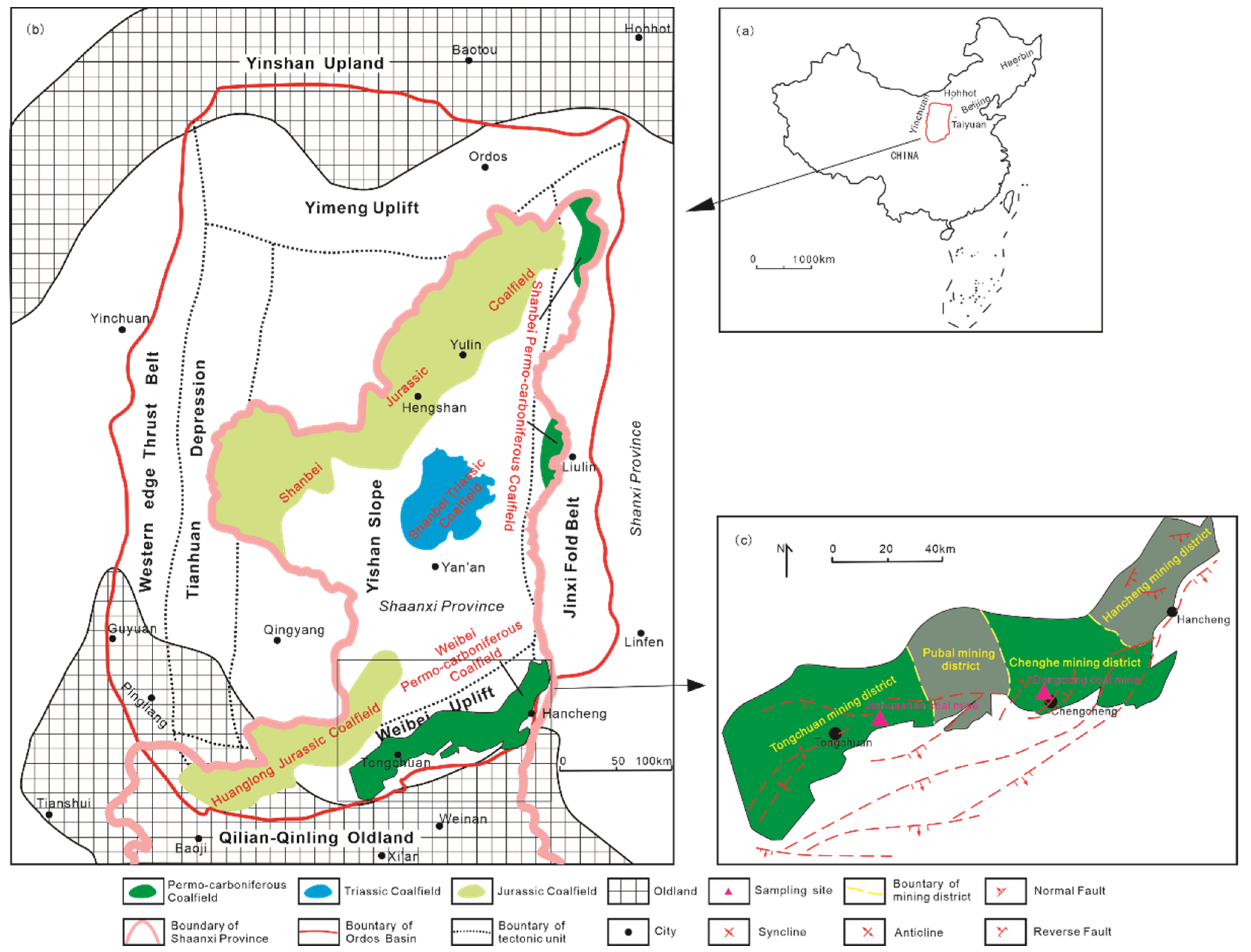
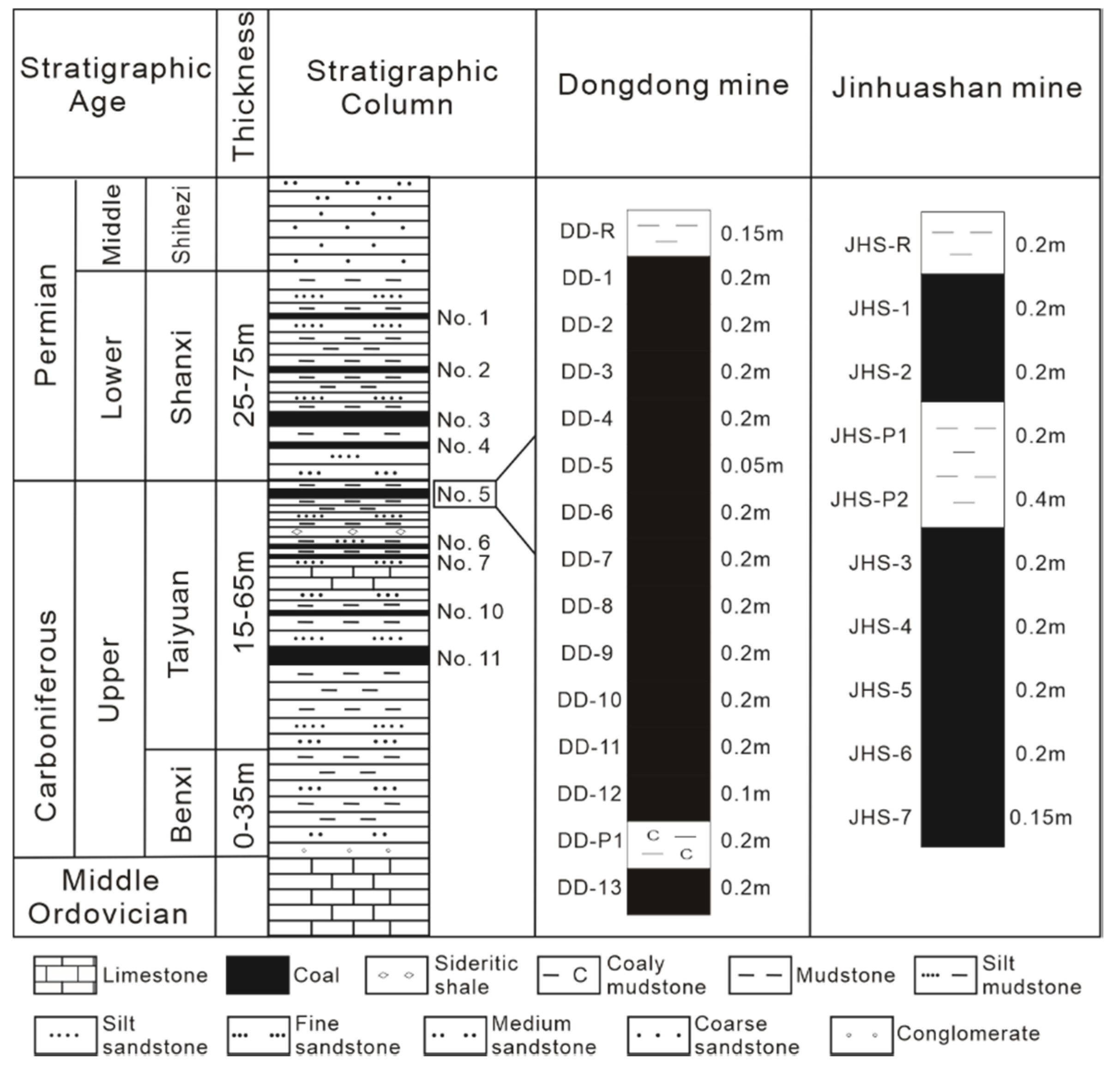
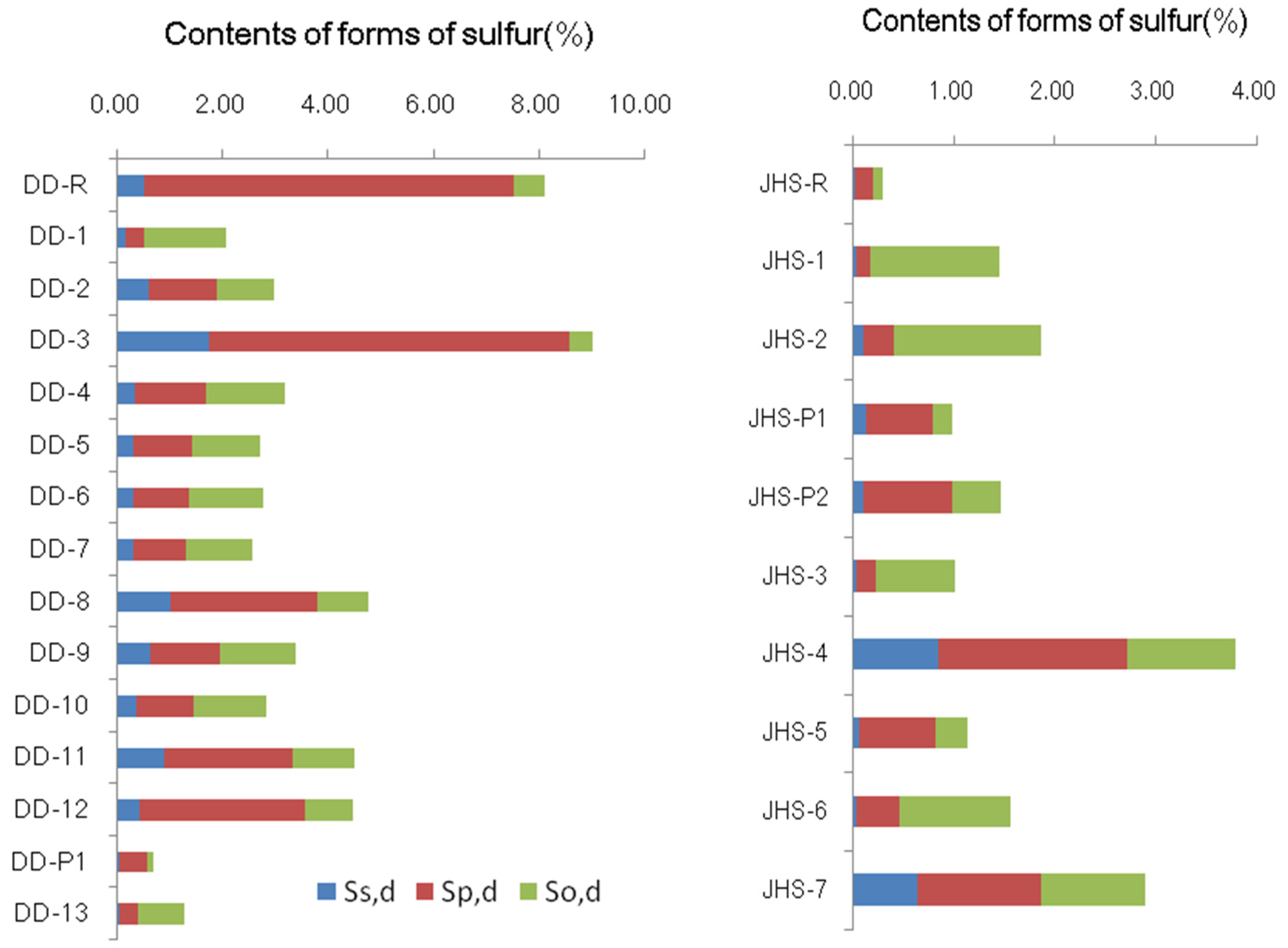


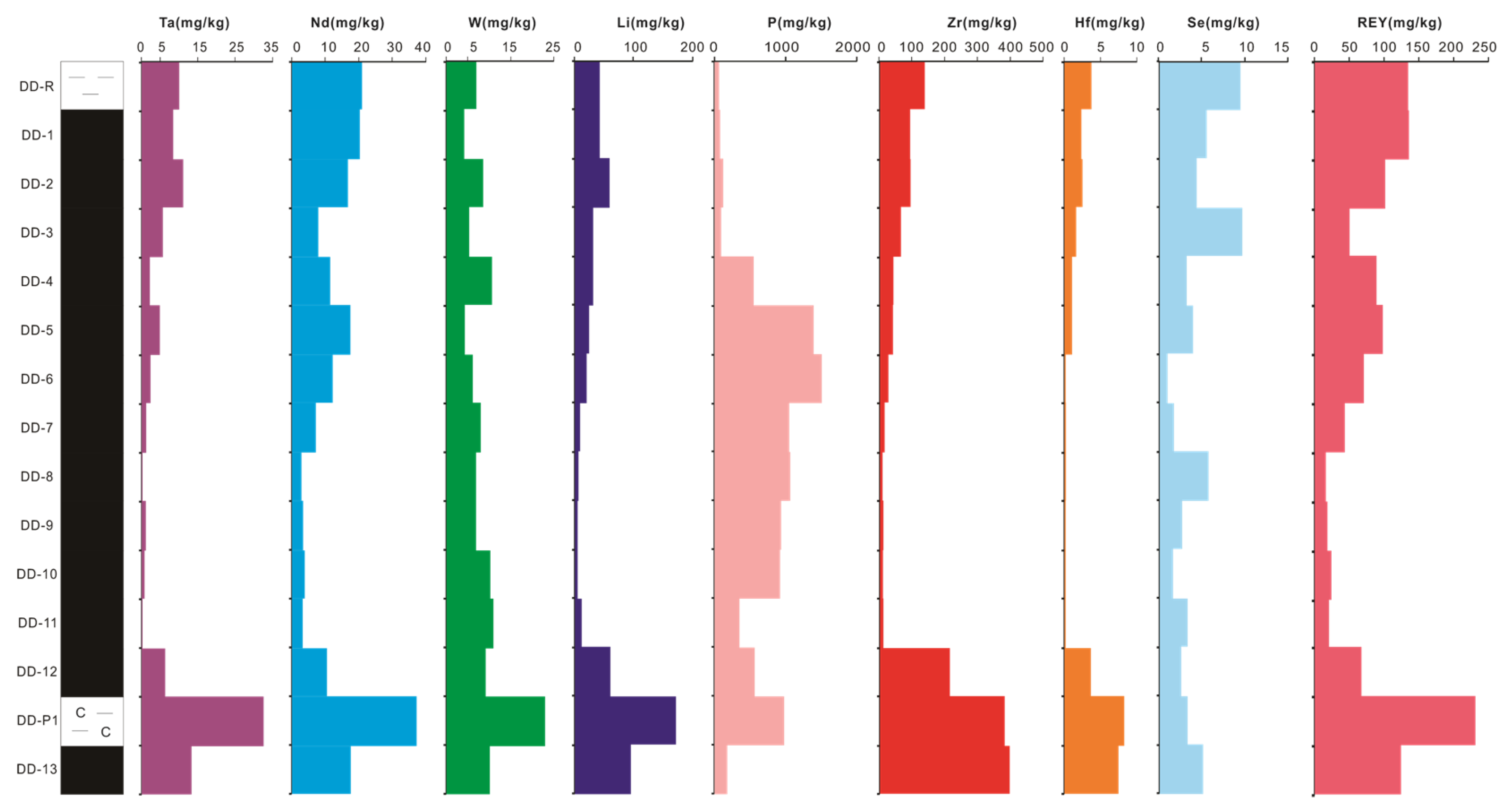




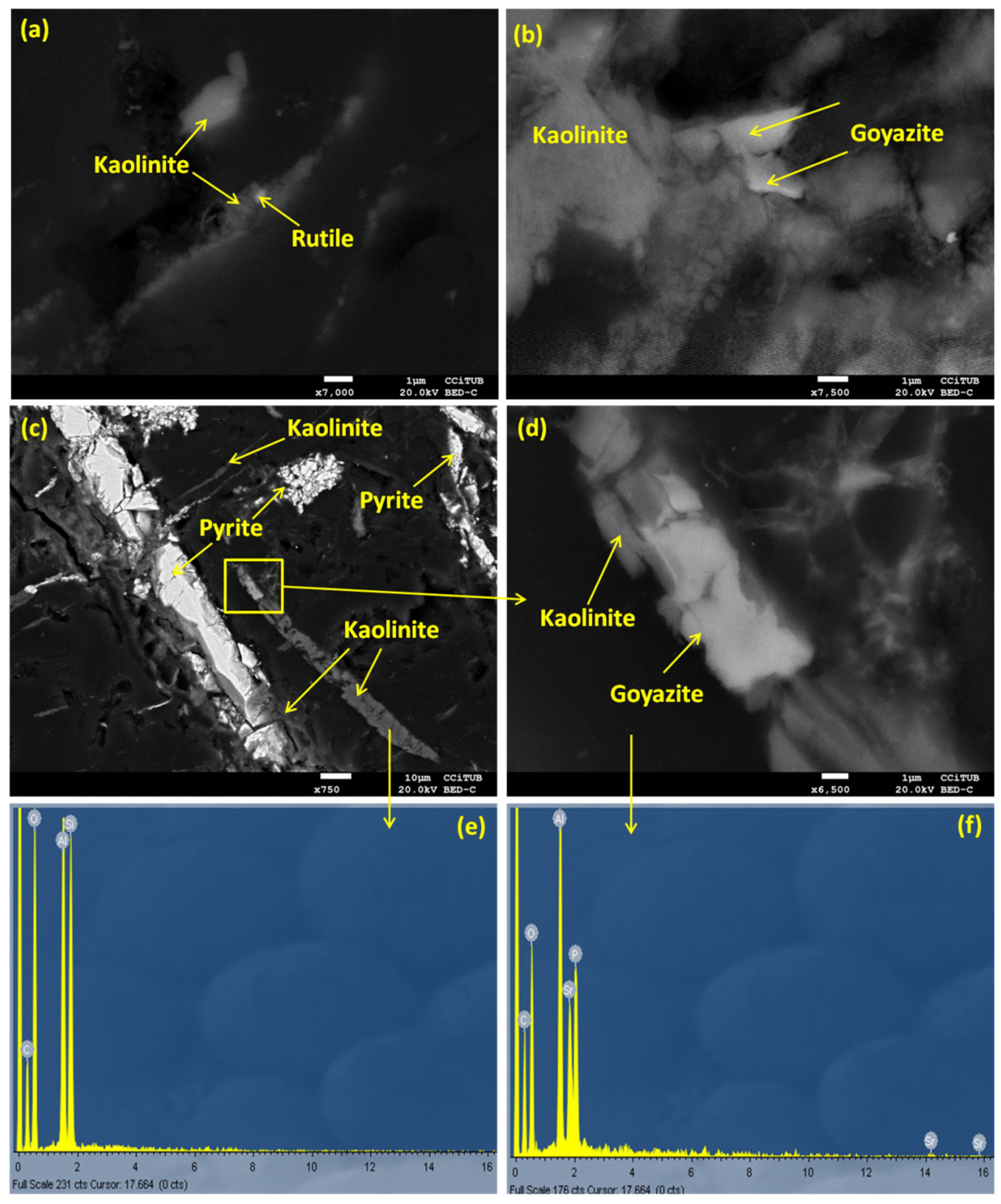
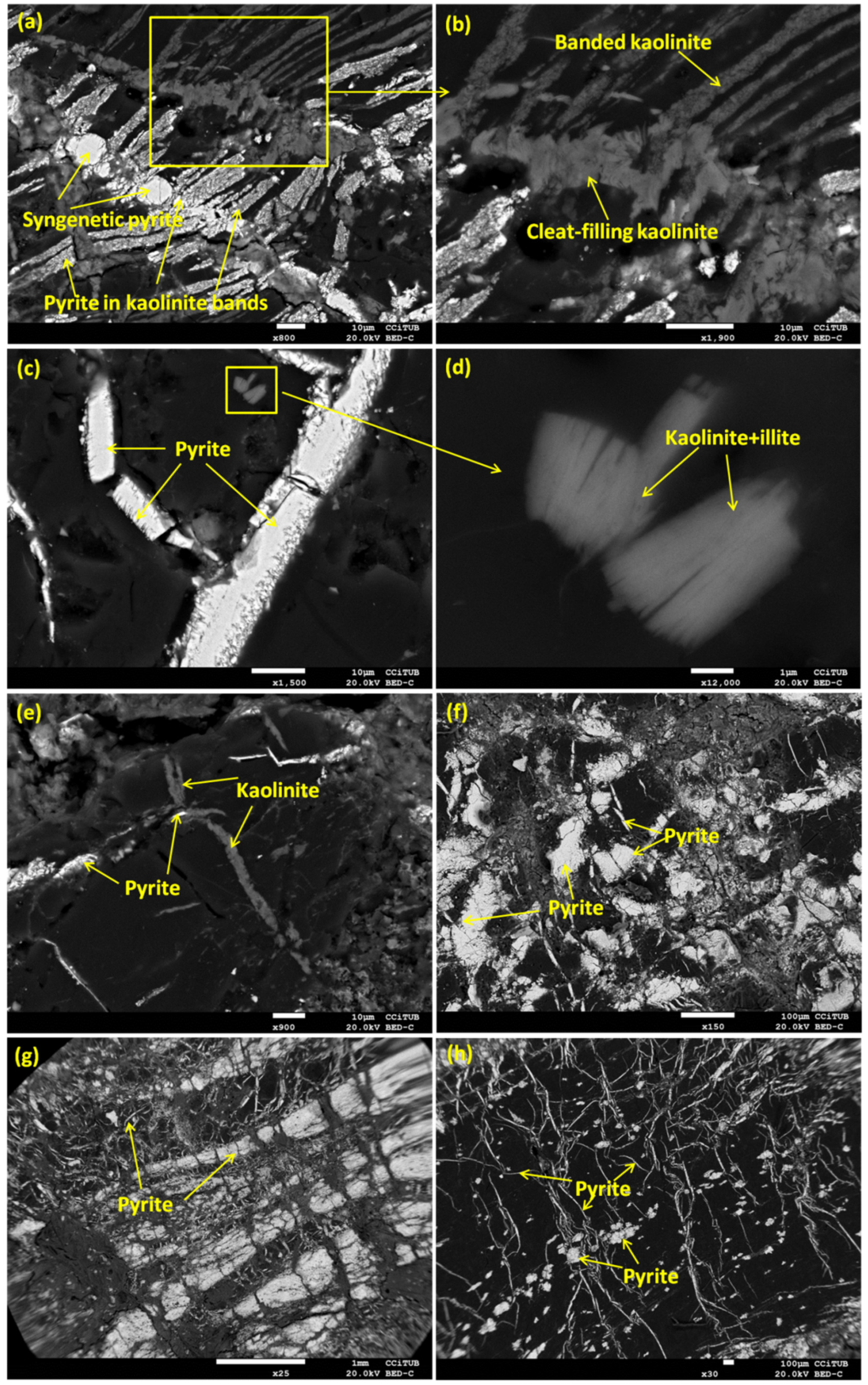
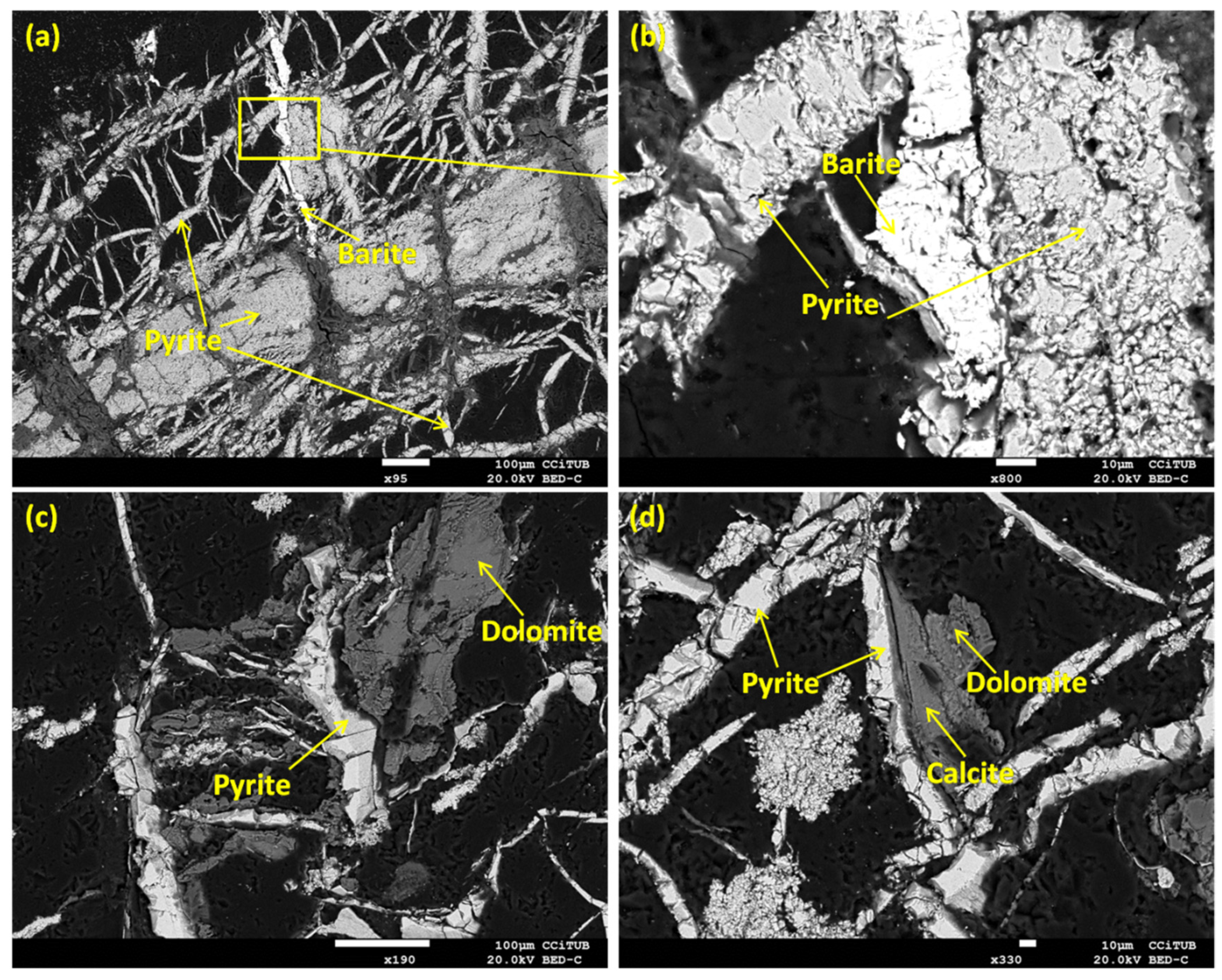
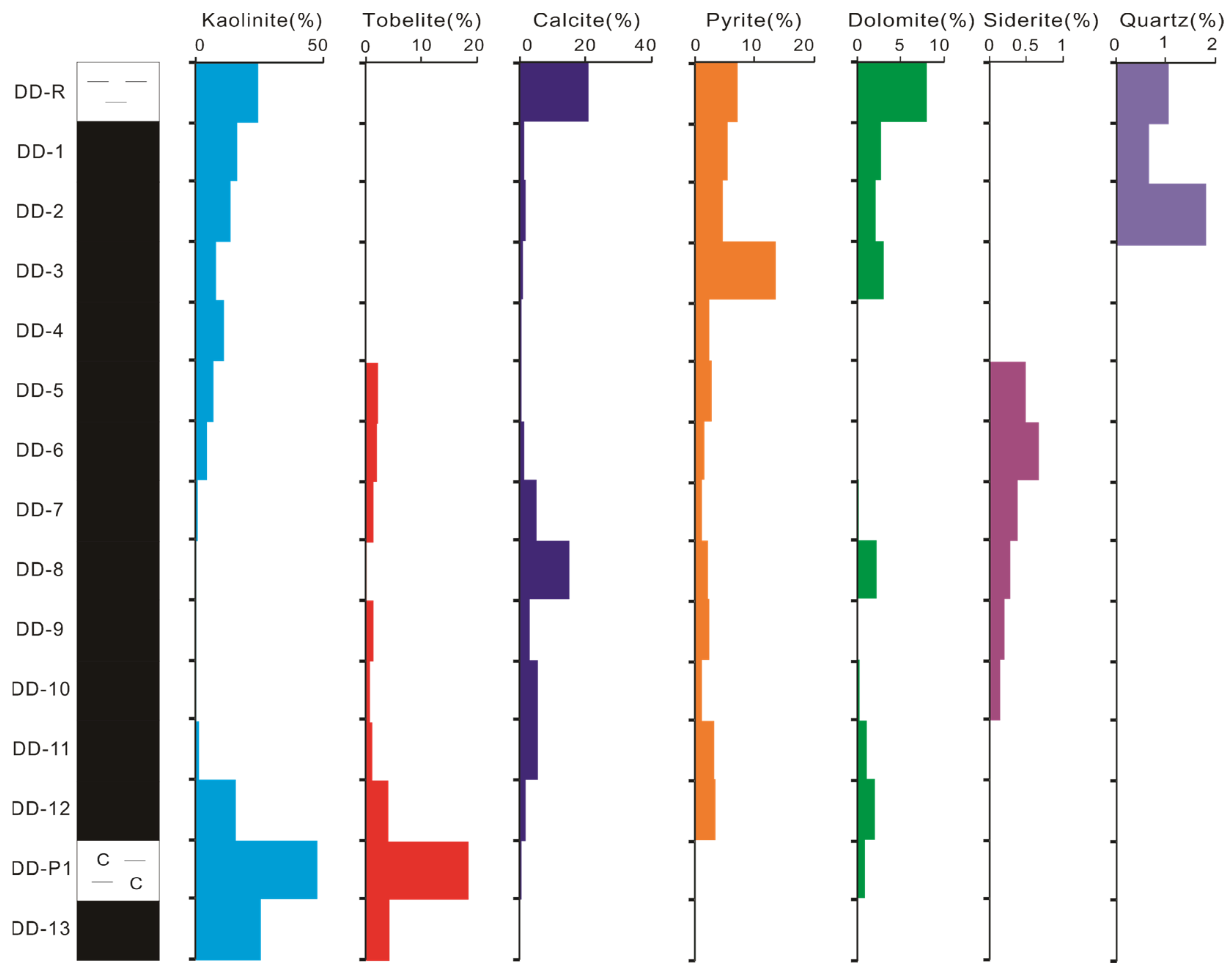
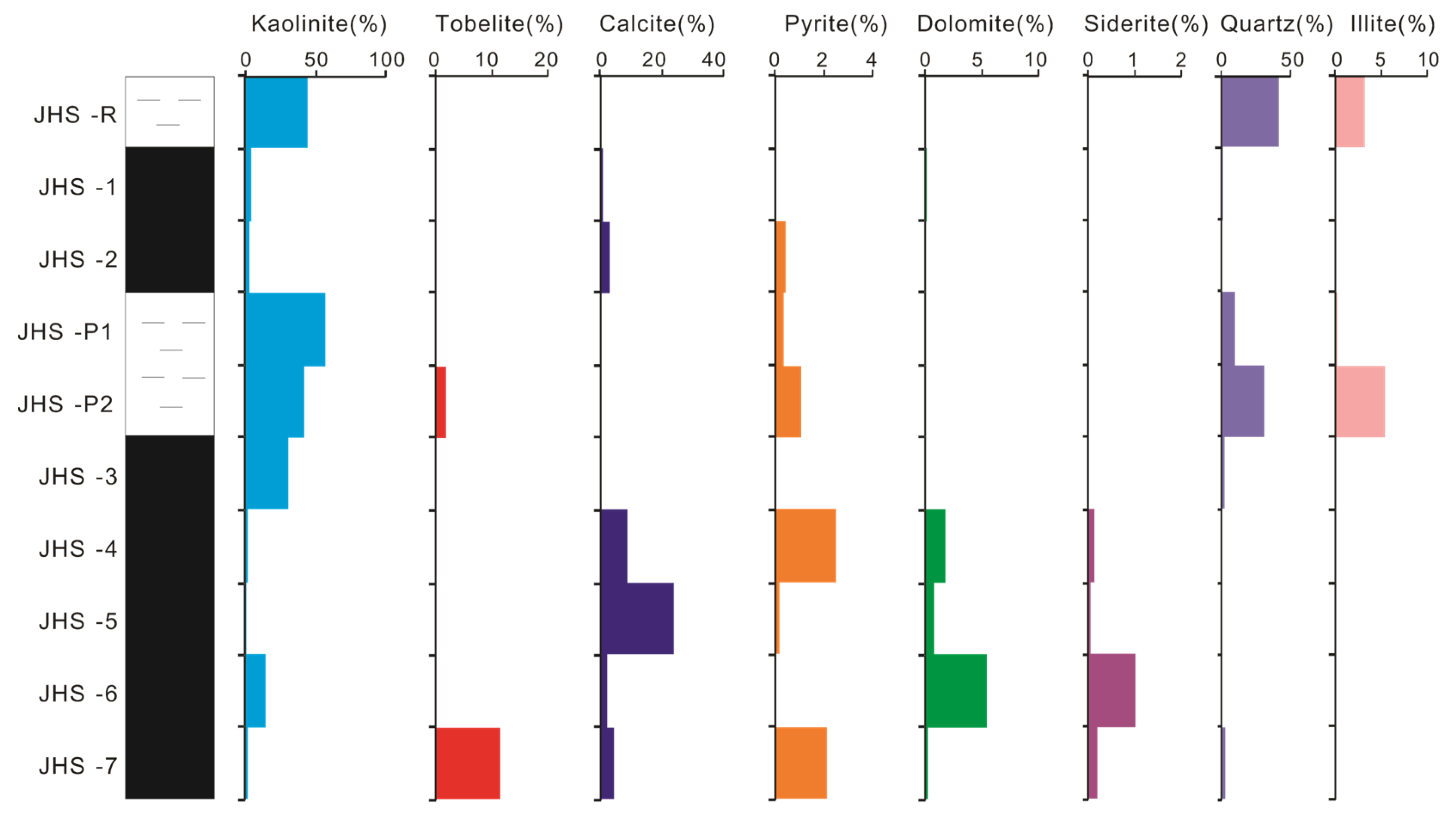
© 2020 by the authors. Licensee MDPI, Basel, Switzerland. This article is an open access article distributed under the terms and conditions of the Creative Commons Attribution (CC BY) license (http://creativecommons.org/licenses/by/4.0/).
Share and Cite
Li, J.; Zhuang, X.; Querol, X.; Moreno, N.; Yang, G.; Pan, L.; Li, B.; Shangguan, Y.; Pan, Z.; Liu, B. Enrichment of Nb-Ta-Zr-W-Li in the Late Carboniferous Coals from the Weibei Coalfield, Shaanxi, North China. Energies 2020, 13, 4818. https://doi.org/10.3390/en13184818
Li J, Zhuang X, Querol X, Moreno N, Yang G, Pan L, Li B, Shangguan Y, Pan Z, Liu B. Enrichment of Nb-Ta-Zr-W-Li in the Late Carboniferous Coals from the Weibei Coalfield, Shaanxi, North China. Energies. 2020; 13(18):4818. https://doi.org/10.3390/en13184818
Chicago/Turabian StyleLi, Jing, Xinguo Zhuang, Xavier Querol, Natalia Moreno, Guanghua Yang, Lei Pan, Baoqing Li, Yunfei Shangguan, Zhejun Pan, and Bo Liu. 2020. "Enrichment of Nb-Ta-Zr-W-Li in the Late Carboniferous Coals from the Weibei Coalfield, Shaanxi, North China" Energies 13, no. 18: 4818. https://doi.org/10.3390/en13184818




